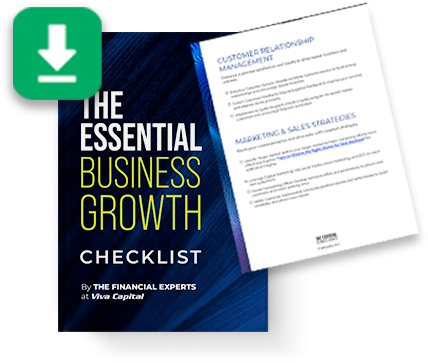
Already valued at $625 billion globally, asset-based lending for businesses is expected to more than double in the next seven years, according to Maximize Market Research. Small businesses, which often struggle to raise capital through traditional debt and equity instruments, are driving this surge. On this page, we’ll cover how it works, its benefits and risks, and what’s involved in preparing for an application so you can ensure your business gets the right funding for your needs.
Understanding Asset-Based Credit: What it is and How it Works
Asset-based lending (ABL) is a form of alternative business financing in which loans are provided to a business and secured by company assets. It’s sometimes referred to as collateral-based lending. With ABL, you can unlock the value trapped in your assets to provide liquidity for operations, expansion, or other financial needs. If you’re deciding between financing options, understanding the differences between purchase order financing vs factoring can be crucial in choosing the right solution for your business.
The asset-based lending process is fairly straightforward. A lender evaluates the asset you want to use as collateral and determines what percentage of the asset’s value it can provide as a loan. The funds may then be disbursed in a lump sum or offered as a line of credit. If they’re provided as a lump sum, you’ll pay the balance back in installments with interest, similar to the way a term loan works. If you receive the funds as a line of credit, you can tap into it as needed and pay the balance back like you would a credit card.
Types of Assets Used for Lending Purposes
A few examples of assets commonly used in ABL include:
- Receivables: The most commonly used type of asset in ABL is receivables. Often referred to as accounts receivable financing, the process involves receiving a loan based on the value of your invoices. A close alternative is invoice factoring. Rather than receiving a loan and debt that must be paid back, the business sells its invoices to the factoring company, and the client that owes the balance pays it, not the business.
- Inventory: Using inventory as collateral, businesses borrow against the value of products they hold before they are sold.
- Equipment: Heavy machinery, office equipment, and other tangible assets can be used as collateral in an equipment loan.
- Real Estate: Commercial properties can also be used, though this is less common in ABL compared to traditional mortgage lending.
Asset Valuation for Lending
The amount of money your lender is willing to provide based on the value of your collateral is referred to as the borrowing base. The lending value of an asset is determined through appraisals and evaluations by the lender, considering factors such as market value, condition, and the liquidity of the asset type. Receivables are evaluated based on factors like the age of the invoice and the creditworthiness of your client, while inventory is assessed on scalability and market demand.
Asset Liquidity and Lending
Asset liquidity refers to how quickly and easily an asset can be converted into cash. It plays a crucial role in ABL. Highly liquid assets, like receivables, can support higher borrowing amounts, while less liquid assets, such as specialized equipment, may be discounted more heavily by lenders. It’s generally best to work with a lender who understands your industry and can provide an accurate valuation to ensure you receive the highest amount of funding possible. Businesses in asset-heavy sectors, such as construction, may also benefit from specialized contractor financing options that address the unique cash flow challenges of project-based work, offering alternative funding solutions when traditional ABL terms may not be ideal.
How to Unlock the Full Value of Your Business Assets
Asset-based lending (ABL) empowers businesses to convert their assets into working capital. To maximize borrowing capacity and secure funding, companies should strategically leverage collateral and optimize asset value.
Maximize Asset Value
Lenders determine the borrowing capacity by evaluating the type and value of assets used as collateral. High liquidity assets like accounts receivable, often receive better advance rates compared to inventory or equipment. To enhance credit availability, maintain detailed and up-to-date asset records, such as receivables aging reports and inventory valuations. Regular maintenance and comprehensive documentation help preserve asset value, expanding the borrowing base.
Optimize Financial Records
Accurate financial documentation is essential for securing an ABL facility. Key records, including balance sheets and receivables summaries, reflect the quality of your financial and physical assets. Addressing overdue payments and managing receivables effectively can strengthen collateral value and improve borrowing terms. Maintaining liquidity and adhering to financial covenants are crucial for building lender confidence and ensuring smooth operations.
Strategically Use ABL Facilities
ABL facilities offer a flexible alternative to traditional loans by using assets as collateral. This financing option is ideal for businesses seeking secured funding with customizable terms. Competitive advance rates make ABL particularly appealing for middle-market businesses leveraging receivables or commercial real estate. By understanding how to use these facilities effectively, companies can achieve financial goals while maintaining operational stability.
By prioritizing asset liquidity, maintaining accurate documentation, and strategic use of ABL facilities, businesses can maximize the value of their assets. This approach enables growth opportunities without incurring excessive financial risk.
Benefits of Asset-Based Lending for Businesses
Asset-based financing options offer many benefits, especially over traditional loans. Below, we’ll take a look at these and compare asset-based lending vs. traditional loans.
Improved Liquidity and Cash Flow
Small businesses often struggle with cash flow, especially when they’re growing. Because ABL unlocks capital trapped in assets, cash flow improvement is easily achieved.
Greater Flexibility
Asset loan terms and conditions often have more flexibility than traditional loans. The borrowing base can adjust with the value of the collateral assets, which can be particularly beneficial in times of growth or fluctuating asset values. Moreover, the use of funds is generally not as restrictive as it might be with other types of financing, giving you more discretion over how you leverage the capital.
Increased Access to Funds
Asset-based loan eligibility is primarily based on the value of assets rather than a long credit history or strong business credit score. Because of this, asset financing strategies work well for younger businesses and those with thin credit files compared to other forms of lending.
Competitive Rates
The assets secure asset-backed business loans, so lenders often view ABL as lower risk. This can translate into more competitive rates for the borrower compared to unsecured lending options.
Reduced Dilution
Often, younger businesses that don’t qualify for loans are forced into equity financing, which means giving up equity stakes in the company. This isn’t a concern when leveraging assets for loans.
Customizable Structures
ABL can be tailored to the specific needs and assets of your business, allowing for a more customized financing solution. This could involve a revolving line of credit based on receivables and inventory, a term loan secured by equipment, or a combination of these things.
Support Through Cycles
Asset-based lending can provide vital support through various economic and business cycles. Since the funding is tied to tangible assets, you might find maintaining or securing loans with business assets easier through downturns, assuming the assets retain their value.
Speed to Funding
The process of securing an asset-based loan, particularly when based on receivables, is often faster than other business financing solutions. This makes it easier for you to respond quickly to financial emergencies, changes, and opportunities.
Asset-Based Lending for Working Capital
Asset-based lending allows a company to borrow against various types of collateral, providing additional working capital for your business when rapid growth or new opportunities arise. In particular, middle-market businesses may not be eligible for traditional bank loans, but they can use asset-based loans or lines of credit to improve cash flow and meet their working capital needs. This lending solution involves the use of physical assets, such as equipment or real estate, as collateral, allowing businesses to access financing options that align with their unique circumstances. Asset-based loans offer competitive rates and customizable structures, allowing companies to capitalize on growth opportunities while securing the necessary funds.
Navigating the Asset-Based Lending Process
It’s essential to understand the components of an ABL deal to make informed decisions and ensure a positive financing experience. We’ll review a few key aspects below.
Addressing Asset-Based Lending Risks
Familiarizing yourself with the risks of ABL can help you prepare for issues and avoid some of the pitfalls.
- Asset Depreciation: The value of collateral assets can decrease over time, potentially affecting the borrowing base and the amount of credit available. This is less of a concern when you’re leveraging an asset like your receivables.
- Operational Oversight: Lenders may require more frequent financial reporting or operational oversight, which can become a hassle for businesses. Work with a partner that digitizes and automates the process as much as possible to minimize the impact.
- Costs and Fees: ABL might come with additional costs, including appraisal fees, facility fees, and potentially higher interest rates, affecting the overall costs of borrowing. Choose a lender that offers competitive rates to start.
- Liquidity Risk: In cases where your business cannot repay the loan, the asset may be liquidated. Sometimes, this is not enough to recover the entire loan amount. Be prepared to cover the difference or choose an option like invoice factoring, in which you’re able to supply an alternate invoice of equal or greater value or draw from your reserve.
Preparing for the Asset-Based Lending Application
While each lender is different, preparing for the ABL application is typically straightforward. A few things you’re likely to need are outlined below.
- Financial Documentation: Have your financial statements, including balance sheets, income statements, and cash flow statements, ready.
- Asset Inventories: Compile comprehensive lists of assets intended as collateral, including invoices, inventory reports, and equipment lists, with as much detail as possible. Your lender can walk you through specifics.
- Legal and Compliance Documents: Ensure all legal documents related to asset ownership and company operations are in order and readily accessible.
- Business Plan: Having a solid business plan can help lenders understand how the borrowed funds will be used and how the loan fits into your overall strategy.
Understanding Terms and Conditions of Asset-Based Loans
Asset-based loans have different terms and conditions than traditional loans. It’s essential to familiarize yourself with them before signing a contract.
- Borrowing Base: Understand how your borrowing base is calculated, including which assets are eligible and how their value is determined.
- Covenants: Be aware of any covenants or conditions tied to the loan, such as financial ratios you must maintain or restrictions on further borrowing.
- Fees and Interest Rates: Review all associated fees and interest rates and how they are calculated to avoid surprises.
- Default Conditions: Know what constitutes a default and the potential consequences, including how quickly the lender can call the loan or take control of the collateral.
Explore Asset-Based Lending for Your Business
Financial planning with asset-based loans can seem complicated, but it doesn’t have to be. At Viva Capital, we offer a variety of alternative funding solutions to help ensure you’re matched with the right options for your needs. Factoring, for example, is as accessible as asset-based lending, but it is often easier to manage and doesn’t create debt that your business needs to pay back. To learn more or get started, request a complimentary factoring quote.
- 7 Proactive Tactics for Avoiding Invoice Disputes - March 3, 2025
- Proven Business Networking Strategies to Amplify Your Growth - January 6, 2025
- Overcome Loan Rejection: Next Steps for Business Financing - October 21, 2024



